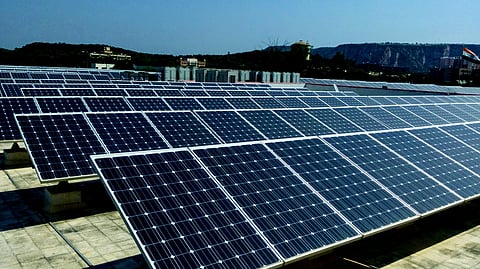

India faces a paradox in its energy sector, with 44 GW of renewable energy ready for deployment but lacking demand due to the absence of Power Purchase Agreements.
Despite the country's push for renewables, coal remains dominant, posing economic and environmental risks.
High costs, storage challenges, and demand-side weaknesses hinder the integration of renewables into the grid.
India is on the verge of an energy explosion — not from fossil fuels, but from sheer demand. With energy consumption projected to grow at over three per cent annually for the next 20 years, the country’s energy appetite is unmatched among large economies. Yet, despite record-breaking growth in renewable energy (RE) capacity, the sector faces a surprising barrier: a lack of demand.
A senior industry expert at Bharat Electricity, a global energy forum, on September 2 sounded the alarm on what he called a “paradoxical crisis.” While 44 gigawatts (GW) of renewable energy capacity is ready for deployment, it’s stuck in limbo, awaiting Power Purchase Agreements (PPAs). Meanwhile, several states — including Uttar Pradesh, Madhya Pradesh, and West Bengal — are signing fresh contracts for coal-based power plants.
“This is not just an energy issue — it’s an economic and environmental risk,” Alok Kumar, director general of All India Discom Association warned. “We’re locking ourselves into high-cost, high-emission contracts while affordable green power is going unused.”
Despite global praise for its renewable push, India’s domestic energy mix remains heavily fossil-fuel dependent.
In FY23, 79 per cent of domestic energy came from coal and lignite. Renewables, excluding large hydro, accounted for just 3.8 per cent of domestic energy production. Factoring in oil and gas imports (over 85 per cent and 50 per cent respectively), renewables’ share drops even further.
“We are dangerously dependent on imported fuels. For a country aiming for energy self-reliance, this is unsustainable,” Kumar noted.
While solar and wind prices have fallen significantly, India’s tariffs remain higher than global benchmarks. For instance, solar power in Saudi Arabia is nearly half the cost of that in India.
“High cost of capital, GST, duties, and import taxes are all contributing to inflated RE tariffs,” he explained.
Storage-backed renewables — critical for peak hour supply — are not yet commercially viable. A recent NVVN tender in Uttar Pradesh discovered a tariff of Rs 6.6 per unit for four-hour storage-based supply, subsidised by a 30 per cent Viability Gap Funding (VGF). Without the VGF, the real cost climbs to nearly Rs 9 per unit — too expensive for most discoms.
A former secretary of the power ministry, Kumar emphasised that India’s clean energy problem is now largely demand-side driven.
“We have capacity, but we lack the systems and incentives to absorb it,” he said, highlighting barriers such as:
· High costs of integrating RE into the grid.
· Technical and financial strain on thermal plants due to frequent ramping.
· Poor grid flexibility and a lack of smart meters for demand response.
India’s electricity share in total energy consumption stands at just 20 per cent, compared to 28 per cent in China. Without greater electrification of mobility, cooking, and industrial heating, the country will struggle to absorb growing RE capacity.
“Electric vehicles and electric cooking aren’t just climate solutions — they’re necessary for grid efficiency and energy security,” he stressed.
He also addressed misconceptions around electric vehicles (EVs), arguing that EVs remain cleaner than fossil-based mobility even with India’s coal-heavy grid, due to their superior efficiency.
While affordability and sustainability often dominate the energy debate, the expert pointed out that “reliability” is the third — and often overlooked — pillar.
India’s System Average Interruption Duration Index (SAIDI) is 600 minutes per year, compared to just 35 minutes in Thailand and 46 in Malaysia.
“You can’t attract AI, data centres, or semiconductor fabs with unreliable power. We need urgent investment in urban and industrial distribution infrastructure,” he said.
To overcome these challenges, he suggested five key reforms:
1. Enhance storage incentives: Increase VGF and promote longer-duration battery storage.
2. Accelerate demand electrification: Expand electric mobility, cooking, and industrial processes.
3. Deploy smart meters and demand response: Enable real-time load flexibility to handle variable RE.
4. Reform must-run rules: Transition to market-based mechanisms instead of mandating all RE as must-run.
5. Tailor RPO targets by state: Customise renewable purchase obligation (RPO) trajectories based on local capability and grid strength.
“Not every state can jump from 15 per cent to 29 per cent RPO in one go. Pushing too fast will raise costs and reduce affordability,” Kumar noted.